Hill Prairie Biodiversity Is the Center of a Thriving Ecosystem
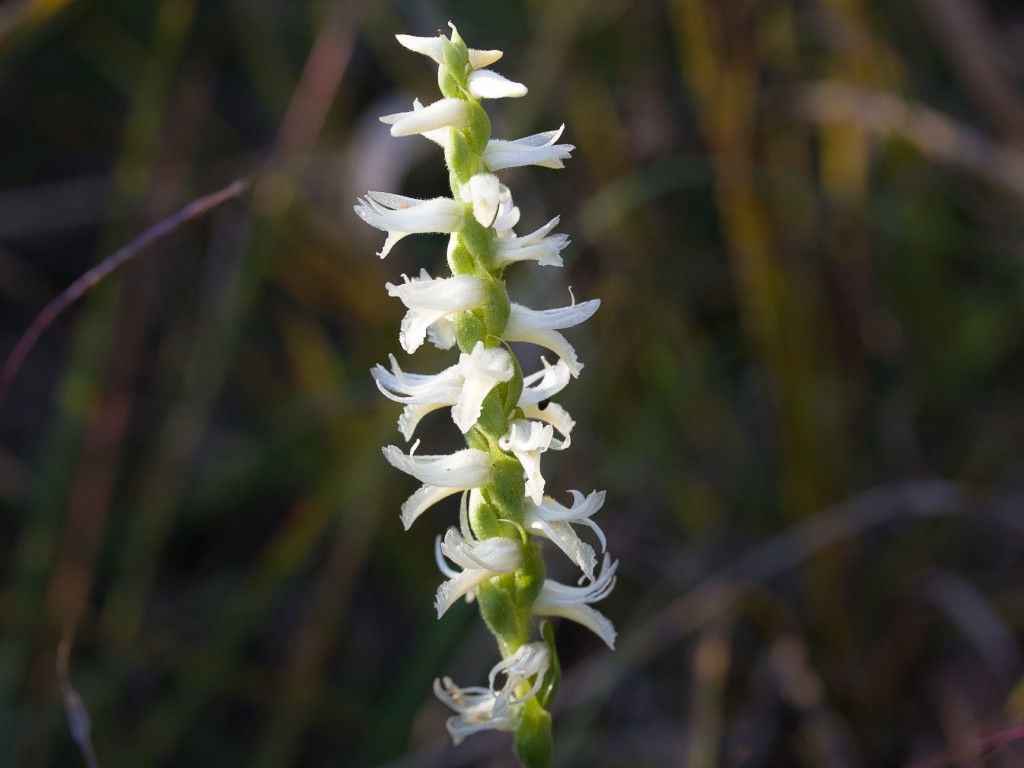
Great Plains Ladies' Tresses orchids bloom late in the year. The small flowers make their presence known by sending a vanilla scent wafting on the early fall winds. Photo courtesy Martin Kemper, Clifftop.
Nearly all of Illinois’ one-time vast 22 million acres of tallgrass prairie no longer exists, even in living memory. By 1830, farmers began to realize that tallgrass prairie soils were more fertile than forest soils and much easier to convert to agricultural use, especially after John Deere’s inspired 1837 creation of a steel plow, a technological innovation that brought previously un-plowable lands into production. By 1900, most of Illinois’ tallgrass prairie was gone. Today, only one percent of the original sea of grass remains in the state. In an ironic twist the very “sodbuster” pioneers who broke the great prairies for agricultural bounty now protect many of the small remnants, for pioneer cemeteries, untouched by plow and mower, now harbor small leftovers of tallgrass prairies.
Also remaining, however, are variations on tallgrass prairie called hill prairies. Hill prairies are distinctive natural communities occurring along the bluff tops of major rivers in the Midwest. They are island-like small patches of prairie growing on the steep south- and southwest-facing slopes immediately above the cliffs. The hot, windy and dry conditions on the slopes discourage all but the hardiest prairie plants.
The bluff lands of Monroe County historically were almost completely forested, excepting on the cliff edges and in forest openings, called glades. Today, our bluff lands are home to more hill prairies than any other county in Illinois. Many of the hill prairies can be easily spotted from Bluff or Levee Roads, clinging to the slopes, from the tree lines to the cliff edges. The steep slopes of these prairies – rightly nicknamed ‘goat prairies’ for the requisite navigational agility they require – saved them from transformative agricultural use. The hill prairies of Monroe County differ from others in the state because of a unique geologic history.
Pleistocene glaciers that covered most of Illinois — which were responsible for the pancake flatness of most of our state — didn’t quite reach the edge of the bluff corridor. Our landscape is really a geographic extension of Missouri’s Ozark Plateau jutting into Illinois. As a result, our hill prairies host some unusual plants and animals, more characteristic of Missouri and the West, and that are rare or nonexistent elsewhere in Illinois.
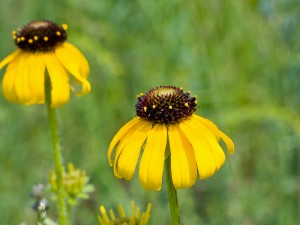
Missouri coneflowers cast a yellow glow on late summer hill prairies. Photo courtesy Martin Kemper, Clifftop.
In common with any prairie ecosystem, our hill prairies are a collage of plants — broad-leaved plants called forbs and grasses — growing close together and both sharing and competing for resources. In an arms race for resources — sunlight, soil moisture and nutrients — the plants take turns at growth and flowering. Small, short forbs grow and flower earlier racing ahead of the taller grasses to stay in the sunlight. These earliest growing flowering plants include alumroots, oxalis, whitlow grass, blue-eyed grass, bluets, cleft phlox, and puccoons. They are the first to flower, but are largely dormant by June.
By midsummer, three tall grasses dominate the hill prairies: thigh-high side-oats grama, waist-high little bluestem, and head-high Indian grass. As the grasses turn to fall colors, complete setting their seeds, and begin to dry out and die back, it is time for the “composite” flowers. A dozen species of goldenrods, and numerous asters come into bloom in late summer, setting their bright colors against the dominant orange and golden-tans of the still-upright drying grasses.
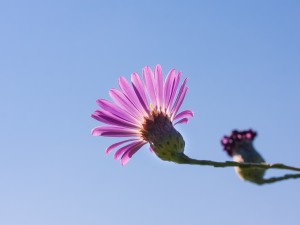
Asters are an important nectar source for late summer and fall insects and also are the larval host for Pearl Crescent butterflies. Photo courtesy Martin Kemper, Clifftop.
Members of the Solidago genus, goldenrods, the harbingers of autumn, are taken for granted, often overlooked as too common for consideration, sometimes seen as weeds and sometimes despised. Part of the disdain comes from the misperception — a complete falsehood — that goldenrod pollen causes common allergies, the “hay fevers” of sneezing, wheezing, and tearing eyes. Only plants that have wind borne pollen could cause such respiratory allergic reactions and goldenrod pollen simply is far too heavy to waft on the wind. The real culprit is ragweed, which blooms at the same time as goldenrods and often grows close by them. The two plant types differ in their pollination schemes: goldenrods attract insects as “hired hands” to transfer pollen in exchange for nectar currency; ragweeds, which have tiny greenish flowers, cast their fate and an enormous quantity of pollen into the air for wind sex.
There are 14 species of goldenrod in the bluff lands of Monroe and Randolph Counties. They come in various heights and varieties of leaf shapes and grow in diverse places, and extend their palate of yellow shades through late summer and early autumn. Early, late, Missouri, tall, field, rough, rigid, and showy goldenrods grow in our fields, prairies, forest edges and roadways. Woodland and elm-leafed goldenrods can be found deep in our shady woods. Gray goldenrod can be found only on our clifftop hill prairies. Buckley’s and petioled goldenrods are rarities occasionally found in our woodland forest glades.
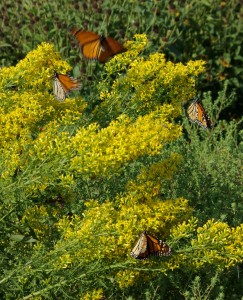
Goldenrod flowers also provide nectar for later season insects, such as these Monarch butterflies gathering energy to power them onward for their annual migration to Mexico. Photo courtesy Pen DauBach, Clifftop
Goldenrods remain the single most important plant for bees, both our native bee species and the European species of honeybees. Goldenrods provide a late-season nectaring source for bees stockpiling sugar sources for their over wintering larvae in the nest hives. It is a particularly crucial food source plant for our native bees, many of which do not live in colonies, but reside in solitary nests, each caring for their own offspring and next summer’s generation.
Sunflowers also bring a wash of yellow color to the bluff lands in fall. The genus Helianthus is native only to the New World and contains between 70 to 80 species. There are 11 species of sunflowers native to our area. Thin-leaved, woodland, small-woodland, and pale-leaved sunflowers grow deep in bluff woodlands. Sawtooth and bristly sunflowers flourish along forest edges. Petioled and prairie sunflowers can be found at field edges and along sunny roadways.
While both sunflowers and goldenrods stand tall to display their blossoms, Rudbeckia, our third most prominent flower in early autumn, provides shorter, dark-centered blooms to color the bluff landscape. Also known as coneflowers, and, sometimes as “the Susies,” or “the Beckies,” Rudbeckias add yellow tints from early summer up to the time of frosts. Missouri coneflower (Rudbeckia missouriensis), which occurs only in our area in all of Illinois, can be found in hill prairies and forest glades.
In delightful counterpoint to fall’s yellow flowers are asters, giving the bluff scape a final splash of whites, purples, and blues before winter sets in. There are 120 species of asters in North America; 38 in Illinois; and 17 in Monroe and Randolph Counties. All share a unique flower structure. The yellow centers are composed of hundreds of tiny fertile florets, called disk flowers. The petals, which display whitish to violet, to blue, to purplish hues, depending on the species, really are sterile appendages, called ray flowers.
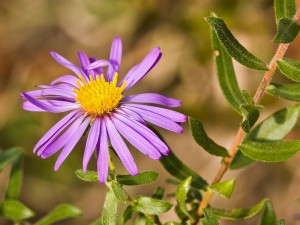
This fragrant aster casts a a lovely color for us and advertises "good eats" for insects in search of nectar. Photo courtesy Martin Kemper, Clifftop.
Of our 17 species of asters, about a half dozen have whitish ray flowers; the remainder shows shades of blues and lavender-purple. Asters grow in a myriad of places: open fields and woods, hill prairies and glades. All of our native asters are important food plants for Pearl Crescents, our most common and abundant butterfly. The yellowish, brown mottled, one-inch wing-spanned butterflies love to congregate on moist sites, forming “puddle clubs” which can number in the dozens. There are three generations (broods) of Pearl Crescents in the bluff lands each year, from April through October. Pearl Crescent females lay their eggs only on asters, which serve as the sole food source for the caterpillar larvae. The third brood’s larvae over winter on asters and metamorphose into butterflies early the next spring.
One of the finest places for late season wildflower viewing is at Fults Hill Prairie Nature Preserve. The forest floor of the preserve shows off an autumn tapestry of pale lavender and light violet Drummond’s asters (Symphyotrichum drummondii), with accents of woodland goldenrod (Solidago ulmifolia) scattered along the woodland floor. The hill prairies at Fults host some of the finest displays of silky aster (Symphyotrichum sericeum) in our state, with the sun-splashed buff tops setting aglow the silvery-shaded foliage and the deep lavender to purple flowers. In September, cliff or Drummon’s goldenrod (Solidago drummondi) arch deep-gold blooms at the very cliff’s edge of the hill prairie. Late summer insects can be found nectaring among the asters and goldenrods, drinking deep for nourishment as the days grow steadily shorter.
For the lucky and all-senses observant hiker, an autumn trip to Fults Hill Prairie Nature Preserve may hold a special wildflower discovery made possible by the scent of vanilla in the clear fall air. Hidden among the drying grasses, but sending out a rich aroma, are flowering spikes of Great Plains Ladies’ Tresses, Spiranthes magnicamporum. The lovely orchid sports multiple half-inch long white blooms arranged around the stalk, which can be nearly a foot long. In decided contrast to the spring flowers’ tendency to grow short and bloom fast before the prairie grasses tower overhead, Great Plains Ladies’ Tresses snuggle close among the tall grass, with only their scent giving indication of their presence.
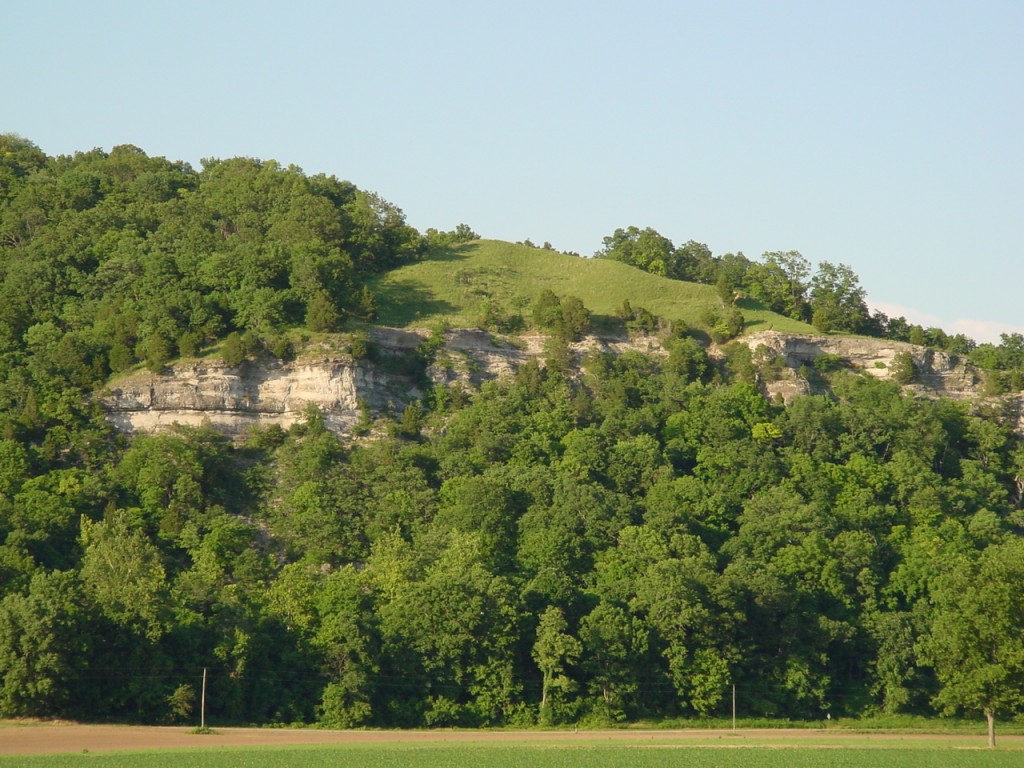
A late summer or autumn hike at Fults Hill Prairie Nature Preserve holds numerous wildflower discoveries and spectacular views. Photo courtesy Martin Kemper, Clifftop.
Fults Hill Prairie Nature Preserve was established in 1970. Located just south of the Village of Fults along Bluff Road, the 532-acre site contains the largest complex of loess-soil hill prairies in Illinois. In 1986, the U.S. Department of Interior’s National Park Service designated Fults Hill Prairie a National Natural Landmark. There are only 600 such landmarks in the entire country. Our bluff lands shelter a little known, one-of-a-kind natural national treasure, in our own backyard.
Clifftop and the Southern Chapter of the Illinois Native Plant Society are hosting a Fall Wildflower Walk at Fults Hill Prairie Nature Preserve from 10 am to 2 pm on Saturday September 10th. We’ll be looking for asters, goldenrods, and additional fall bloomers and, of course, sniffing the air for hints of vanilla that might show us where the ladies’ tresses bloom. The program is free and open to the public. The hike requires moderate to strenuous effort, and includes areas of steep slopes. Participants should wear weather-appropriate clothing and bring drinking water and a snack and/or lunch for themselves. Parking is limited so we encourage people to car pool if possible. Parking for the Nature Preserve, with the reference address of 2482 Bluff Road, Prairie du Rocher, is approximately 1 mile south of the town of Fults, IL, off of Bluff Road.
CLIFFTOP, a local nonprofit organization, is focused on preserving and protecting area bluff lands.
A version of this article was published in the 2 September 2016 edition of the Monroe County Independent.
© 2016 all content rights reserved Clifftop NFP
Comments are currently closed.
